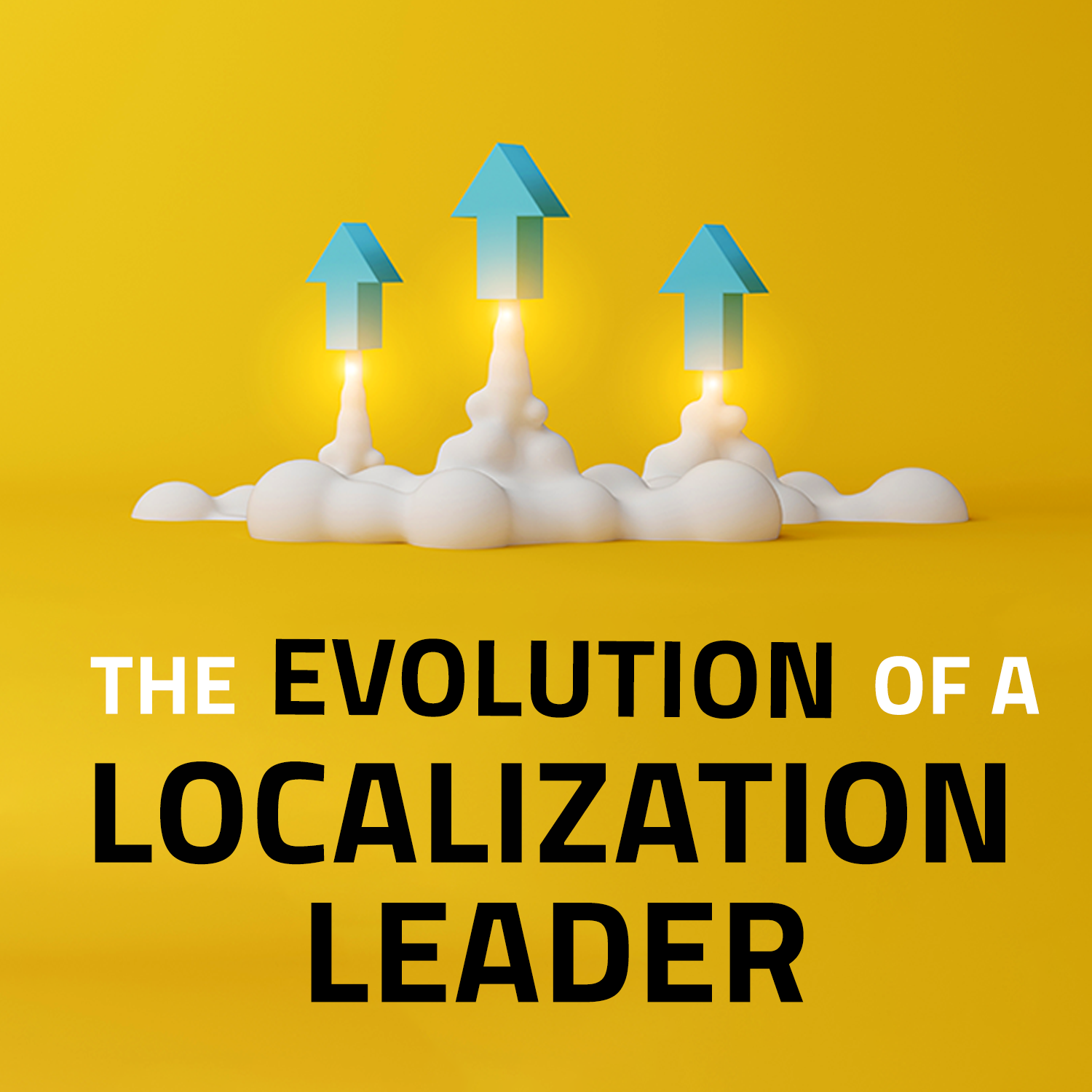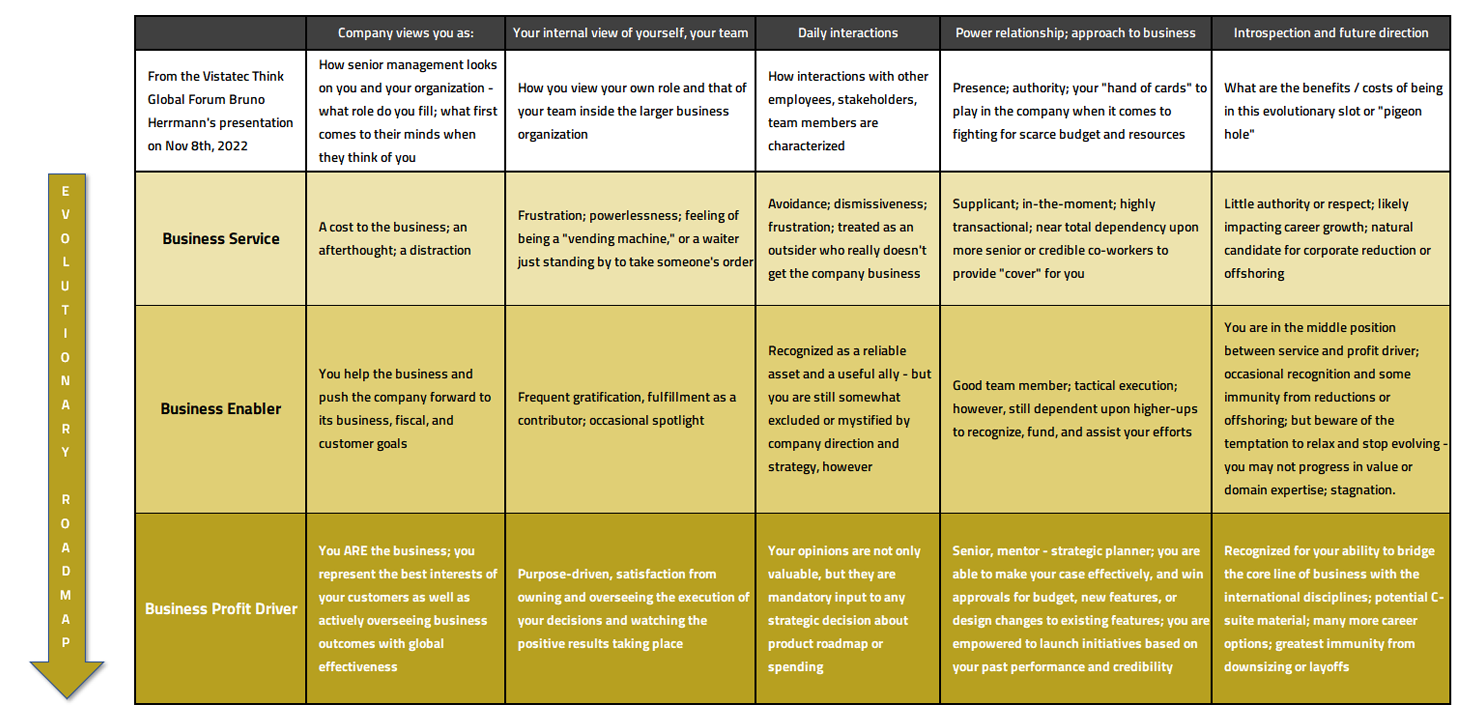
Subscribe to our newsletter and be the first to be notified when new content is released
Localization Leadership – Exclusive to Vistatec.com
Empty headin
The Evolution of a Localization Leader
Robert Sarver, Director, Solutions Architecture, Vistatec
In this month’s Localization Leadership article, we bring you an opinion piece by one of Vistatec’s most experienced localization professionals, Robert Sarver, prompted by the perspectives of another great industry leader during a recent Think Global Forum event.
In this blog, we explore the following:
- An interesting framework for viewing the career growth and perception of localization professionals
- Some ways of thinking about each of the three stages: Business Service, Business Enabler, and Business Profit Driver
- Three tips from my personal experience on how to move up the ladder from one step to the next
The Idea
In his presentation at our recent Think Global Forum event in Berlin, Bruno Herrmann spoke of the perception of localization leaders within their organization. He put forward the idea that they are seen to fit into one of these three levels, like points along a spectrum:
- Business Service
- Business Enabler
- Business Profit Driver
This started me thinking about what I’ve seen in the evolution of people’s careers in our industry over the past 30 years. Watching friends and colleagues navigate change in light of the many developments we’ve seen in international business and technology, I began asking myself – what would a 360-degree view of a localization professional’s career and contributions look like? Was there a pattern or helpful information that could be derived from it?
As I tumbled this idea around in my head, I wanted a framework that allowed me to visualize a localization professional’s career evolution holistically – something that could serve as a roadmap for professional development and business strategy. Borrowing from Bruno’s commentary in his presentation, I came up with the following.
Big Bang Theory of Localization Careers
To download this table, please click here ![]()
The first column illustrates the evolutionary steps previously mentioned by Bruno Herrmann.
The second and third columns describe the viewpoints that frame the internal and external narratives that a localization professional experiences as he/she grows from one stage to the next.
The fourth column describes daily interactions with peers, subordinates, and seniors.
The fifth column describes the “struggle for survival” – the jockeying that everyone faces in a business, where scarce resources must be allocated among competing priorities and agendas.
The sixth and final column discusses the risks, benefits, and future direction of someone who finds themselves in each growth stage.
Now, let’s summarize each stage.
Business Service
This first stage is characterized by meeting the bare minimums for handling translations well – handoff, hand back, invoicing, and project tracking. The goals here are reliability, availability, and predictability. As a service, you want to be viewed almost as a utility or commodity; flip on the light switch, and the light comes on every time. You want to be so good that people take you for granted – just like electricity or water.
Yet there’s little challenge here; opportunities to stand out are few and far between – which is the flip side of being a utility. When is the last time you remember someone raving about their electricity supplier or local water authority? The formulaic manner in which these localization activities are carried out makes them ripe opportunities for offshoring or automation.
Nearly everyone starts here – both companies and individuals. There are important lessons that everyone in our industry learns from serving in such roles. Moreover, companies just starting need to blaze their trail to international market expansion in whatever ways meet their needs the best. And as they say, there’s no better place to start than at the beginning.
To achieve significant international growth (as well as career growth), it would be a mistake for a person – or a company – to stay here very long. We may start in a crib, but it would be a mistake to stay in the crib forever.
Business Enabler
In this second stage, the environment has changed. The localization professional is seen as a valuable part of the business cycle. Internal resistance is lessened. There’s a general acknowledgment of the value that you and your department bring to the table.
In many ways, this is the most alluring and deceptive place to be. A person in this stage avoids the friction and the daily frustration of being viewed as a Business Service. They are contributing, and there’s much to applaud in the contributions themselves. They are comfortable.
However, that person may fail to reach his/her full potential. Stagnation is dangerous here for the company and the individual’s career. And as other companies (and employees) around you continue to progress, the comparison may not be flattering. You could look like you’re standing still or losing ground. Your company could appear to be using yesterday’s processes and technology while competitors are leveraging cutting-edge solutions. Who will they hold accountable for the lack of vision if that happens?
Business Profit Driver
Nearly everyone values what you say about issues or proposals in the third and final stage. You’re an in-demand person, someone whose judgment carries weight. You understand your employer’s business to a high degree of precision. You demonstrate horizontal and vertical knowledge of your business operations, clients, and competitive landscape.
You’re five steps ahead, thinking about where you want the company – and your career – to be several years from now. You’re well-connected to the industry; you have a network of professionals at your fingertips. Maybe you are even contributing to the next generation of localization professionals somehow.
As a Business Profit Driver, this third horizontal row represents the best outcomes possible in each vertical category. It’s the gold standard, the nirvana, where all localization professionals ultimately want to be. And frankly, this is where most of the challenges, risks, and exhilaration can all be found. This is where the real fun is.
Thought Experiment: One Event, Three Different Responses
Another way to think about these levels is to conduct a thought experiment: how might someone in each level respond to the same external event or stimulus? For example, suppose your company wants feedback on a proposal to add another supported language to your product or service.
- Business Service – this person will be thinking about things like these. Their goal is to answer the “what”:
- What are the word counts and file types?
- Can my current vendor handle this language, file type(s), volumes, and schedule?
- Can we do this with our existing tools?
- Business Enabler – this person will be thinking about such issues as these. This person’s goal is to answer the “how”:
- How solid is the managerial commitment to this new market or language? Are they “all in,” or is this just a toe in the water?
- Can I leverage existing product lines or markets to make this work easier or less expensive?
- What other departments will be impacted by this decision, and how do I get what I need from them?
- Business Profit Driver – finally, this person will be thinking about such questions below. Their objective is to deal with the “why” of it all:
- Where does this opportunity fit with the rest of the company’s business goals – how does it stack rank against everything else we want to do?
- What other initiatives, markets, or languages should we consider before making this decision final?
- What are the regulatory and competitive repercussions of taking our product/service into this new market?
- How long will it take to recoup the initial investment to enter this new market?
- How will I measure the success or failure of this initiative – what are the criteria, and when are the signs of success/failure likely to manifest themselves?
As you can see from our thought experiment, the kinds of concerns and questions asked at each level also follow the same evolutionary glide path. This path starts with elementary problems and transactional issues, moves to tactical, execution-based questions, and concludes with strategic issues focused on the company’s business and future direction.
Moving From One Level to the Next - What It Takes
If you’ve bought my argument so far, the next natural question is, “how does a person graduate from one level to the next?” I’d like to offer the following three tips that have served me well over the years – although I also admit that I am still learning and improving in all three areas.
Tip #1: Master Your Data
Don’t just collect the data. Don’t just repeat the data. Understand the data – what it covers and what it doesn’t. Understand trends and lead/lag indicators. You should be ready to answer questions such as the following ones because your audience may ask them as well:
- How reliable is your data? – how many time periods does it cover? Was everything included? Or did some data only start being measured recently?
- Who gathered it? – did it come from the field? From Finance? From Technical support? How confident are they? Do they have any agendas that would influence the data?
- What compromises were made? – did you have to round any data up or down? Were sales figures from two product lines merged into one?
- What assumptions did you make? – data is rarely perfect, yet you still have to collect it and provide business recommendations. Robert Heinlein once said, “Every important decision we will ever make will be made with incomplete data.” Simply make your assumptions reasonable, then declare them so that they are out in the open. That way, your audience has all the facts, and you are insulated against concerns of data error or misrepresentation concerns.
- Data vs. noise – keep in mind that one data point does not a trend make and don’t force-fit a trend onto noisy data. Even if you have a trend, don’t get ahead of your data; there are limits to how far the data can support a decision.
- Marginal impacts – of adding the next language, or the next user, or the next test pass. Business decisions often focus on the change that occurs by the next marginal unit.
For more insights, see our article on communicating the right localization data for business decisions.
Tip #2: Get Comfortable Being Measured
For many people, being measured and held accountable can be intimidating. People sometimes distrust it or assume it’s not being done in their interest. And to be fair to such concerns: we’ve all experienced situations where metrics were used as a pretext for some negative outcome.
But in the world of business, being measured is part of the daily routine. We cannot escape it. Remember: we measure what is important to us, and the first step to controlling and improving something is to get good measurements of it. In the right scenarios, being measured brings credibility and can offer a layer of safety against bad outcomes.
The key is to be doing some self-measurement along the way. Nobody likes surprises – not you, not your team, and certainly not your manager. You should always know how your performance, budget, and supply chain measure up. That way, when you or your team are put under the microscope, it’s all familiar territory, and nobody is caught off guard. Performing self-measurement along the way allows you to proactively fix any issues before they become more significant. Therefore, stand up – don’t be afraid to be measured.
We discuss this topic at length in our article on capturing and measuring relevant localization metrics.
Tip #3: Know the Business Method for Effective Q&A
As human beings, we often cloud our communications with too much detail, clutter it with irrelevant information, or fail to organize it so that our audiences can absorb and remember it. In casual, social situations, this isn’t usually a problem. In business situations, however, it’s another matter entirely.
Precision questioning is a skill that is highly prized in certain professions, especially the medical and legal fields. It’s the ability to swat away all the irrelevant rush of information and ask the one (or two) key questions that get at the heart of the issue. What information do you need to break the logjam of confusion or to make the decision? I’ve been in meetings where someone paused for a moment, asked the perfect question, and then the entire room audibly exhaled. It was like a bell of clarity was rung, and the problem – and its solution – suddenly became so simple. Strive to be that person.
Precision answering is also very valuable – leading your response with the critical nugget of information needed and inviting the questioner to dive deeper as he/she wishes. Let them take the information at their own speed and according to their interest level. However, be prepared for the questioner who wants to ‘deep dive’ into a topic (which brings us back to Tip #1: Master Your Data).
It is vital to master this Q&A methodology if you want to be taken seriously. It’s the preferred format for many business venues, such as Quarterly Business Reviews, Feature Design Reviews, etc. In my years, I have seen people enhance their credibility tremendously – or erode it terribly – by asking and answering questions in high-profile forums like these. It’s a practiced art that belongs in the toolbox of every localization professional who aspires to be taken more seriously.
Check our article on messaging article on localization messaging strategies for more perspectives.
Portability and Usefulness
I’d like to draw your attention to a few items before we close our discussion today.
There is admittedly an element of oversimplification in what I’ve written here. After all, if becoming a localization superstar is so evident and straightforward, why isn’t everyone doing it? We all know that sometimes there are issues of corporate culture or internal politics that add extra friction to moving from one stage to the next. Other parts of our lives compete for our attention – school, family, outside interests, etc. However, the excellent business skills described here are always in demand, and you will never go wrong by acquiring (or improving) your abilities in these areas.
Next, as I was writing this article, I noticed an interesting parallel. As a localization professional, the struggles you face internally are the same struggles that language service vendors face when trying to reframe the discussion with our clients, such as how to be taken seriously and how to move from that first row of being seen as just a business service and move to that last row of being a strategic, go-to-market partner. Whether you are on the client or the vendor side, I believe the challenges we all face are very similar – and the advice offered in this article will work for both situations.
Finally, this may seem familiar. There are echoes of the Localization Maturity Model in this framework. None of what I’ve said in this article is revolutionary. It’s just a recap of knowledge you probably already have, with additional views from my experience to hopefully add some context and flavor.
In Conclusion
I hope you enjoyed this entry in our blog series. We discussed:
- An interesting framework for viewing the career growth and perception of localization professionals
- Some ways of thinking about each of the three stages: Business Service, Business Enabler, Business Profit Driver
- Three tips from my personal experience on how to move up the ladder from one step to the next
Stay tuned for my follow-up article, which will be a practical example of how to discuss localization without mentioning localization. It’s a topic that I’ve wanted to write about for a while, as I’ve seen well-meaning individuals in our industry pigeonhole themselves by accident.
Robert Sarver has over 30 years in the international industry in both client and supplier roles. His experience spans software, health care, engineering, and green energy. He is an alumnus of both the University of Washington and Seattle University. He has been with Vistatec for over five years.


Become a Great Localization Leader Today!
Sign up for our newsletter and stay up to date with monthly thought provoking insights, perspectives and tips from the industry leaders


